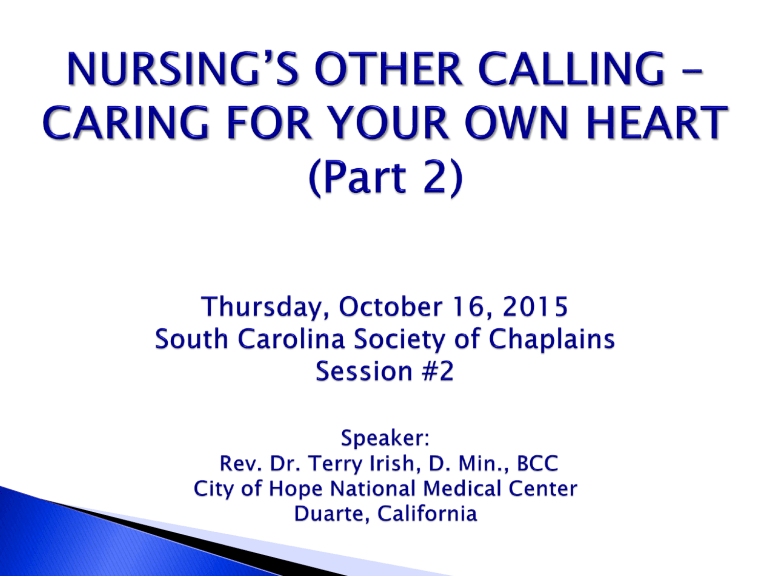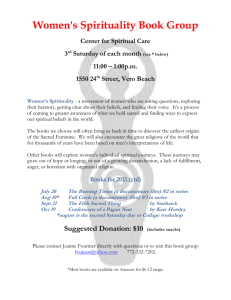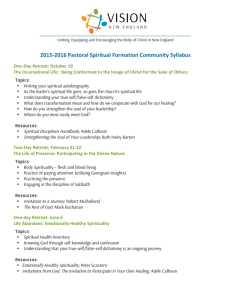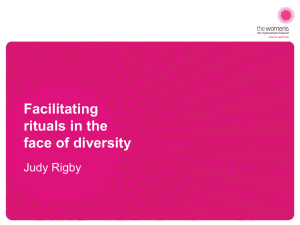Nursings Other Calling: Care of Your Own Heart

SCALE N = 27
1 2 3 4 5
STRONGLY
DISAGREE
DISAGREE NEUTRAL AGREE STRONGLY
AGREE
1. You know your strengths, how to use them to help, support colleagues, care for patients.
26 of 27 scored 4 or 5
2. You know your weaknesses, how to deal with them to protect yourself, family, colleagues, and patients.
23 of 27 scored 4 or 5
3. You can say “No!” without feeling guilty, making an excuse why not, or becoming defensive.
15 of 27 scored 4 or 5
2
SCALE N = 27
1 2 3 4 5
STRONGLY
DISAGREE
DISAGREE NEUTRAL AGREE STRONGLY
AGREE
4. You know how to do good citizen in world.
“self-care” , take care of family, be effective co-worker/colleague, perform job at highest level, and be contributing
21 of 27 scored 4 or 5
5. If you experience stressful/disturbing incident at work, you know how to
“Self-Debrief” to process event, learn and grow, so you will not experience long-term personal/professional harm.
15 of 27 scored 4 or 5
3
SCALE N = 27
In the list below, please check box of any statement that describes how you have felt in the past several months, since the beginning of 2015.
Hypervigilance & exaggerated startle response – being on guard & jumpy.
4 of 27 checked this box
Irritability or angry outbursts.
15 of 27 checked this box
Nightmares & trouble falling or staying asleep.
9 of 27 checked this box
4
SCALE N = 27
In the list below, please check box of any statement that describes how you have felt in the past several months, since the beginning of 2015.
Emotional numbness, lack of interest in activities & difficulty feeling love & joy.
9 of 27 checked this box
Avoiding thoughts & situations that are reminders of a traumatic event.
9 of 27 checked this box
5
SCALE N = 27
In the list below, please check box of any statement that describes how you have felt in the past several months, since the beginning of 2015.
5 Common Symptoms of Post-Traumatic Stress Disorder (PTSD)
Important notes: Of the 27 Pre-Evaluations completed May 14 th :
6 checked 3 of the 5 Common Symptoms of PTSD
2 checked 4 of the 5 Common Symptoms of PTSD
1 checked all 5 Common Symptoms of PTSD
6
Started today’s Session with same Evaluation questions as 5/14.
DNE and I wanted to see how much progress you each feel you have made in past 8 weeks.
Question (honest answer, please): How many of you have used
ANY of the handouts you received on May 14 th to help you address some issues that are most pressing/distressing right now.
If so, which handouts did you find most helpful?
7
Chronic bereavement
Multiple losses, anticipatory, unresolved grief
Compassion fatigue
“The development of negative professional attitudes and behaviors as a result of job strain. Work Environments can cause job strain when the worker experiences frustration, powerlessness, and an inability to achieve work goals.”
(Puchalski & Ferrell, 2010)
Burnout
“… is a response to the work environment and not to the consequences of caring for people who are suffering.”
(Puchalski & Ferrell, 2010)
Particular stressor
Feeling inadequate due to inability to alleviate others’ suffering
(Bright, 1996; Hooyman & Kramer, 2006; Vachon, 2000.)
Stress, cumulative loss, and emotional labor can negatively impact those who care for the chronically ill and dying and can diminish their ability to provide effective care;
Therefore, it is imperative to provide staff with self-care education and opportunities to reflect and process grief to ensure their well-being.
(Nevidjon, 2004; Vachon, 2010; Ferrell & Coyle, 2010)
Recognize stress as an occupational hazard of trauma work
Accept your reactions as normal responses to specialized work
•
Limit exposure to trauma material
Books-conferences-discussions-movies
(Pizanti, 2006)
Develop supportive environment for discussing own reactions to work
Build a network of professional connections
Consider personal counseling to work through issues
Make use of the COH EAP – Employee Assistance
Program
(Pizanti, 2006)
Develop supportive environment for discussing own reactions to loss
Work within supportive organization
Set and maintain clear boundaries on therapeutic relationships
(Pizanti, 2006)
Processing a Death ~ Sample Priming Questions
How did you find out the person died? Were you there or did someone call you?
If you were present, when he or she died, what was that experience like?
Can you identify ways in which this death brought up some experiences of loss from your past?
How has dealing with losses in the past prepared you to deal with the losses you face now? In what ways do you feel illprepared?
What good memories do you have of the person who died?
Think or write a bit about one of those good memories.
(Nichols, 2012)
Spiritual care of Nurses
Identify self-violence, suffering or injury
Empower nurses to care for themselves & others
Promote spiritual, psychological and physical abundance - not scarcity
(Pizanti, 2006)
Explore your own beliefs and values *
Think of a time when you faced a major life transition, change or loss. How did it affect you spiritually? How did your spirituality affect the experience? Did you discover spiritual strength during that time? How did you want to be supported spiritually?
*From “Offering Spiritual Support For Family or Friends” http://www.caringinfo.org/UserFiles/File/faith_brochure.pdf
Take time to laugh, have fun, socialize with co-workers
But not about work
Seek spiritual renewal in your life
Worship – prayer – Scripture + + + (Sacred text)
Emphasize self-care and self-nurturing activities
(Pizanti, 2006)
Take sabbaticals from trauma work – if possible
Take mental health breaks purposefully
(Pizanti, 2006)
Develop hobbies, sports and creative interests
Develop restful, meditative activities
Yoga, music, reading, gardening…
Nurture supportive relationships and roles for yourself outside work
(Pizanti, 2006)
Use nature as a healing force in life
Guard against addictive behaviors
Be rested, fit and eat well
Set clear boundaries between home and work
• Use clothing/rituals to mark change from work to leisure
(Pizanti, 2006)
Nurture a sense of joy, grace, beauty, love and connection in life
Seek out experiences which instill comfort and hope
Connect with community and friends +++
(Pizanti, 2006)
Your presence and compassionate, listening ear are the two most important tools you bring to any intervention.
(Stanley, 2002)
Compassionate Presence = A Way of Being
(Nichols, 2012)
21
Compassionate presence and follow-up
Reflective listening/query about important life
events—spirituality as connection
Support patient sources of spiritual strength and
note in chart
Connect patient to community resources
Referral to chaplain or other spiritual care professional
(Puchalski, 2014)
“My Best Day Ever!”
“I don’t know what your destiny will be, but one thing I know. The ones among you who will be really happy are those who have sought and found how to serve.”
-- Albert Schweitzer
"The best way to find yourself is to lose yourself in the service of others."
-- Mahatma Gandhi
THANK YOU
Chaplain Terry Irish tirish@coh.org
626.256.4673 Ext. 85781
Pager 626.423.0023
Anandarajah, Gowri and Hight, Ellen. Spirituality and Medical Practice: Using the HOPE
Questions as a Practical Tool for Spiritual Assessment. Am Fam Phy 63(1):81-88, 2001.
Bright, R. (1996) Grief and Powerlessness: Helping People Regain Control of Their Lives
(165-167). London: Kingsley.
,
Ferrell, B. R., & Coyle, N. (Eds.). (2010).
NY: Oxford University Press.
Textbook of palliative nursing (3rd ed.). New York,
Fitchett, G., & Canada, A. L. (2010). The Role of Religion/Spirituality in Coping with Cancer:
Evidence, Assessment, and Intervention. In J. C. Holland (Ed.). Psycho-oncology, 2nd
Edition. New York: Oxford University Press.
Hooyman, N. R., & Kramer, B. J. (2006). Living Through Loss: Interventions Across the Life Span, (347-360).
New York: Columbia University Press.
Nevidjon, M. (2006). Managing from the middle: Integrating midlife challenges of children, elder parents, and career. Clinical Journal of Oncology Nursing, 8 (1), 72-75.
Nichols, S.W. Mitigating Care Fatigue in Palliative Care Providers: Developing Self-
Awareness and Self-Care. Archstone Foundation Grant Teleconference, March 4, 2012.
Osterman, Paulette, and Schwartz-Barcott, Donna. Presence: Four Ways of Being There.
Nurs For 31(2):23-30, April-June, 1996.
Peery, B. (2009. What’s in a Name? PlainViews, 6 (2).
Perez, Jacqueline C. Healing Presence. Care Manage J 5(1):41-46, Spring, 2004.
Puchalski, C., & Romer A.L. (2000). Taking a spiritual history allows clinicians to understand patients more fully. Journal of Palliative Medicine, 3 (1), 129-137.
Puchalski, CM, Ferrell, B, Virani, R, Otis-Green, S, Baird, P, Bull, J, Chochinov, H, Handzo, G,
Nelson-Becker, H, Prince-Paul, M, Pugliese, K, Salmasy, D.
Conference. J Palliat Med 2009; 12:885-904.
Improving the Quality of
Spiritual Care as a Dimension of Palliative Care: The Report of the Consensus
Puchalski, CM, Ferrell, B. (2010). Making Healthcare Whole – Integrating Spirituality into
Health Care. West Conshohocken, PA: Templeton Press.
Puchalski, CM, Handzo, G, Prince-Paul, M, Otis-Green, S. Improving the Spiritual Domain of
Palliative Care. American Academy of Hospice and Palliative Medicine, Preconference workshop, San Diego, March, 2014.
Spiritual Care of the Nurse, CH (MAJ) Robin W. Pizanti, RN.
Stanley, Karen J. (2002). The Healing Power of Presence: Respite From the Fear of
Abandonment. Onc Nurs For
Vachon, M. (2010). The experience of the nurse in end-of-life care in the 21st century. In B.
R. Ferrell, & N. Coyle (Eds.),
29(6):935-940 .
Textbook of palliative nursing
H.M. Chochinov & W. Breitbart (Eds.),
(303-319). New York: Oxford University Press.
(3rd ed., pp. 1011-1029).
New York: Oxford University Press.
Vachon, M.L.S. (2000) Burnout and Symptoms of Stress in Staff Working in Palliative Care. In
Handbook of Psychiatry in Palliative Medicine,
Wolfelt, AD. (2002). Healing A Parent’s Grieving Heart. Fort Collins, CO, Companion Press.







